Project Portfolio Management (PPM) software is a critical tool for teams who need help managing complex projects and priorities across their organization. This software isn’t just critical for enterprise organizations, but any company that manages shared resources and has complex projects with succession planning components.
Teams who use PPM software need to organize resources across multiple teams and projects to ensure they are using their limited resources most efficiently. This software is also critical for managing the complexity of interdependencies across the entire portfolio. Companies use PPM tools to optimize their project portfolios to maximize revenue and ROI and ensure no one resource or team member is overworked.
So, let’s dive deeper into the difference between project management and portfolio management.
What is Project Portfolio Management?
Let’s first begin with the broad definition of project management.
Project management is a process used to plan, organize and execute a task, event or project. It incorporates specific knowledge, skills, resources and techniques to achieve a level of value for its stakeholders.
Project portfolio management (PPM) organizes multiple projects in a way that contributes to the overall well-being of the enterprise. At its core, PPM is a process that links project management to more specific enterprise management goals.
For businesses, PPM helps to increase the value of their projects, balances their portfolio and aligns projects with the company’s strategic objectives. An effective portfolio management strategy requires an in-depth analysis to understand where a company is, where they want to be and planning how they are going to get there. It considers the possible risks, rewards, and actual performance of each project to see if it’s even worth green lighting.
For instance, say your company has six large projects in your pipeline, but you only have enough resources to work on four. How would you choose which projects to add first? How will you plan the order in which projects will take place and when each of the projects will begin? How can you evaluate if the project is a good fit based on your company’s objectives, resources and capabilities?
Project portfolio management software can help align these projects with your company goals. Such tools provide a solution to establish a prioritization process for projects that helps organizations govern their existing and future efforts. The software can organize a ranking system to determine projects by value, risk, budget, and resources required. PPM tools also help establish what your project needs are. Businesses find value in PPM software because it can achieve realistic outcomes, forecast revenue and balance workload for their team.
The Top PPM Features
Project portfolio management software offers a comprehensive overview of your project status and health. It also accounts for the resources and dependencies of the portfolio and project requirements. And it’s not just about managing a project lifecycle for PPM. Portfolio management helps to prioritize projects that have the most potential value for the organization and ensures the work being done is aligned with the company’s overall objectives.
Here are some of the key features of PPM Software to help businesses find value in alignment with their goals.
1. Portfolio Balancing
Portfolio balancing is a core feature of the portfolio management process. It offers the ability to plan, coordinate and allocate project resources (i.e., budget, resources, and human capital) that align with the organization’s strategic direction. Key stakeholders are thus better informed and able to understand which items in the portfolio have the greatest impact and potential.
2. Prioritize Projects Across the Organization
The prioritization process ranks the various elements within a company’s strategic or funding initiatives and the organizational focus (i.e., budget savings, product growth, customer satisfaction, project maintenance, and internal operations). This feature ranks the project necessities to support ensuing examination required to validate and balance the project portfolio.
3. Reporting
Reporting is a vital part of any effective project management team. Ultimately, the purpose of reporting ensures that the portfolio is composed of items that support your strategic objectives. For PPM software, reporting offers insight to performance indicators, provides recurring reporting on them, and access to the portfolio items that most align with the business strategy and effective resource utilization. Most reporting features examine all portfolio elements within the timeline goals established by the organization.
Benefits of Project Portfolio Management Software
It’s important to make sure you understand the benefits that these key features can unlock in your organization to ensure you’re selecting the right tool for your business needs. So here are the top five benefits your PPM tool should enable:
- Make optimal funding & resource decisions
- Align departments and business leaders to company-wide priorities
- Schedule resources most efficiently
- Scenario-plan when priorities change
- Analyze project performance across the portfolio
Make optimal funding & resource decisions
Being able to have a bird’s eye view into all projects and resources across the portfolio can give leadership a strategic lens needed to make optimal business decisions. In order to make these strategic funding and resource allocation decisions, leaders need to see all priorities and tasks across the portfolio to prioritize shared resources between teams effectively. And, they need to see when this work is scheduled and forecasted to finish.
Resourcing is a major component of effective project planning. An organization only has so much capital to reinvest into the business each year. No matter how large the company is, there is always a much longer list of ‘needs’ than the company can afford to spend (or has the time to take on). Leaders must be able to assess all funding requests and prioritize the best ones for the business.
Align departments and business leaders to company-wide priorities
Different departments fighting over shared resources is, unfortunately, common in enterprise organizations. But PPM software will align your entire company to the organizational priorities. By basing resource allocation decisions on company-wide goals rather than gut feelings and influence, the proper PPM tool delivers insights, aligned schedules, and outcomes that remove the politics that plague many teams.
Schedule resources most efficiently
Outside of capital expenditures, shared equipment and personnel are likely the biggest resources to align between disparate teams. PPM tools should quickly provide insight into what resources are readily available and which are the most constrained across the portfolio. This allows leadership to eliminate bottlenecks and enable efficiency.
Once priorities are clear and a trusted schedule of resource allocations is established, alignment can be easily achieved. This type of strategic alignment of resources makes planning and scheduling projects much easier and more cost-effective.
Scenario-plan when priorities change
Thinking about taking on a new project, changing priorities, or reducing spend and resources? Then leadership needs to scenario plan realistically by incorporating all of these factors before making those strategic decisions. The best PPM tools make scenario planning quick and easy. These tools should show leaders how those changes affect the portfolio’s project timelines in real-time.
The best PPM tools are dynamic to visualize best-case and worst-case outcomes and compare those scenarios to make the best possible decisions.
Analyze project performance across the portfolio
One of the most significant benefits of a PPM tool is showing your project performance across the entire portfolio. Your PPM software should also provide insights into opportunities to streamline projects and processes. PPM tools will help leaders make the best project funding and resource allocation decisions possible through readily available insights that are easy to digest in a dashboard view. These insights are crucial to optimizing growth and delivering a higher return on investment with each new project delivery.
Now that you know what features and benefits to look for in a project portfolio planning tool, here is our list of the 10 best PPM software tools for 2022.
2022’s 10 Best PPM Software Tools
- LiquidPlanner
- Adobe Workfront
- Wrike
- Oracle Primavera
- Planview Clarizen
- Zoho
- Click-Up
- Monday.com
- Microsoft PPM
- Smartsheet
1. LiquidPlanner
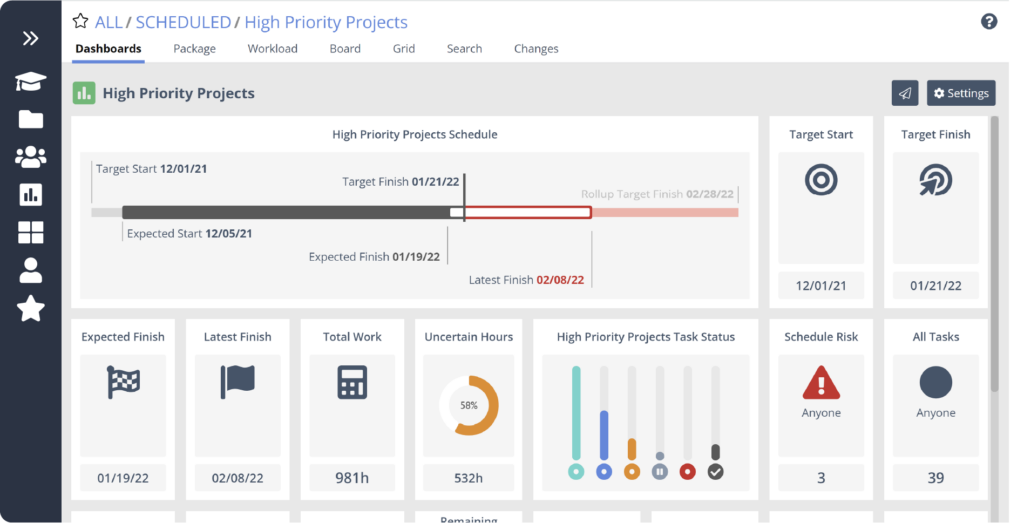
LiquidPlanner is an all-encompassing project portfolio planning solution that helps organizations of any size easily manage complex projects across the entire organization. LiquidPlanner’s predictive scheduling engine is the most unique feature compared to other tools. When priorities shift, scope changes, or resource allocations are made, the scheduling engine automatically updates task priorities and timelines across the entire portfolio. LiquidPlanner’s Planning Intelligence framework is the only platform on the market that guarantees a 90% confidence rate for project timelines. LiquidPlanner has automatic resource leveling across the entire project portfolio, highlighting bottlenecks and underutilization to ensure the organization effectively uses resources.
Top Features:
- Scenario-plan adding new projects, changing priorities, or resources easily
- Automatic resource leveling across all projects and resources in the portfolio
- All-in-one portfolio, project and resource management integrated solution
- Project schedules update automatically in real-time as resources and priorities shift
- Priority-based methodology to align the entire organization
- Real-time insight to bottlenecks & risk across all projects and resources in the portfolio
Directly from the customer: Autumn, Finance Manager at an Enterprise company: “The key advantage is the ability to classify and prioritize a full portfolio of work, and to utilize LiquidPlanner as the primary resource or point of consideration for all ongoing projects in our organization. Everyone knows where to receive the most up-to-date information on a project at any moment, which maintains all project team members speaking the same language in terms of our delivery goals.”
Pricing: LiquidPlanner offers four plan options to meet a variety of customer needs; FREE plan, Essentials Plan ($15 / per user / per license), Professional Plan ($25 / per user / per license) and the Ultimate Plan ($35 / per user / per license).
2. Adobe Workfront

Adobe Workfront is a collaboration tool for enterprise teams to plan, monitor, and execute projects. Workfront boasts a variety of integrations to centralize collaboration for real-time project status visibility. Adobe also integrates with other work automation tools to enable efficiency in project planning. Workfront is geared towards enterprise organizations to streamline review workflows. Their features help teams come together to accelerate the delivery of high-quality work.
Top Features:
- Centralize communication to collaborate more efficiently
- Work automation integrations with CRMs, financial applications, and more
- Project plan templates and standardized status to improve workflow
- Integration with agile processes
- Enterprise security with ISO 27000
Directly from the customer:
Faith, a Technician in the Banking Industry: “It has given us [the] ability to plan, manage, and measure work based on data which helps organization executives to monitor work in real-time using the data. The most important thing is that their support team worked with us from the beginning to create a platform that best fits our job environment.”
Pricing: Pricing starts at about $30 per user per month, according to PC Mag. Workfront doesn’t list prices on its website because the cost varies based on each organization’s setup and installation. Workfront is available in four package tiers and they do not have a free plan option.
3. Wrike
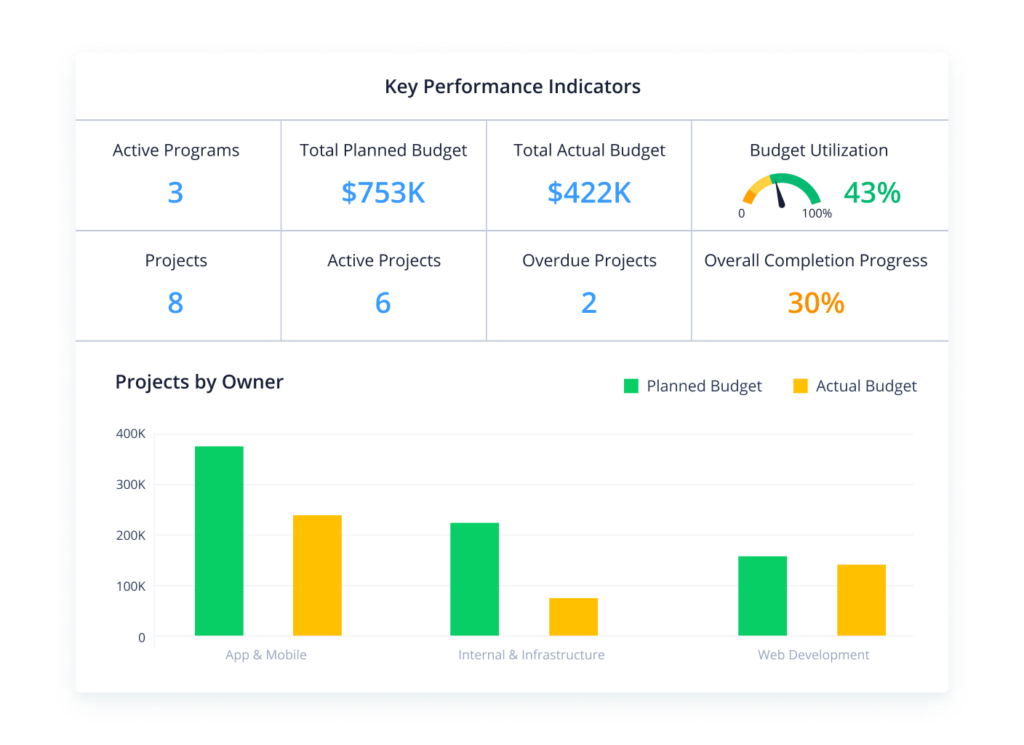
Wrike’s project portfolio management tool combines strategic planning, project tracking, and insight gathering into one platform. Wrike helps your team assess the projects you work on with reporting functionality. Wrike’s tool enables simple collaboration from one secure platform. You can monitor your resources in one work view to gain valuable insights. Its simple and easy-to-use time cards enable better budgeting decisions to help you optimize resource capacity and spend across the portfolio.
Top Features:
- Customized request forms & templates
- Gantt charts, Kanban board views for agile & waterfall projects
- Budget scenario planning
- RAID logs, escalation workflows, and progress reports
- Variety of paid add-on features, including 400 integration
Directly from the customer:
Steven an Integrated Project Manager: “Having a clear view on each department, clicking through departments on Wrike is fantastic. I’ve been able to implement a process for people to just logon to Wrike to see the status of their jobs.”
Pricing: Wrike offers four plan options for a variety of industries: Free | Professional $9.80/user/month | Business $24.80/user/month| Enterprise (contact for pricing)
4. Oracle Primavera P6
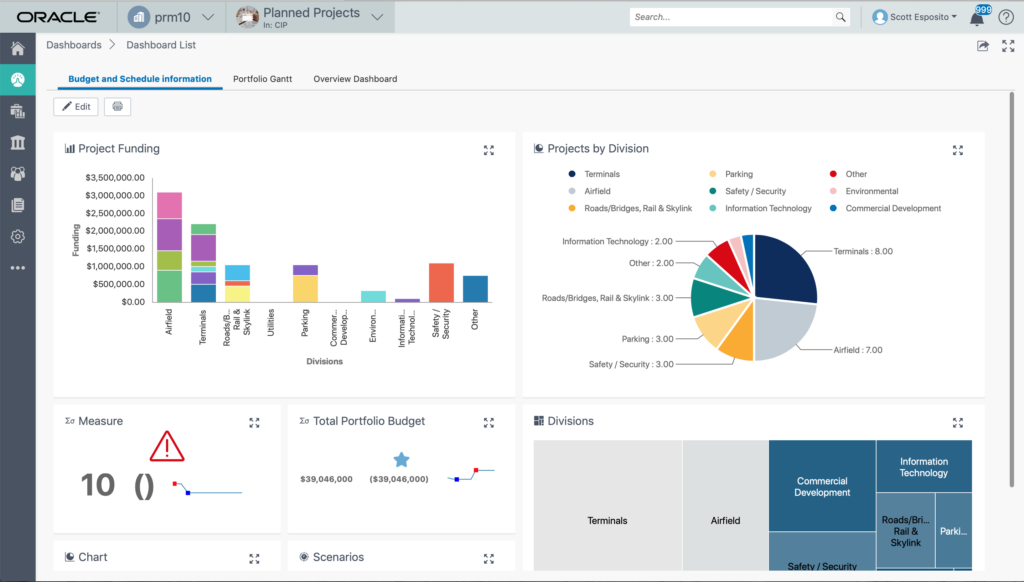
Oracle Primavera’s cloud-based PPM tool integrates project and portfolio planning with risk management, resourcing and scheduling. Primavera focuses their platform on one niche industry – construction. But the software can accommodate projects of any size within the construction industry. Primavera P6 EPPM is a robust solution for construction teams to prioritize, plan, manage, and execute projects. Project views are adaptable to enable you to increase planning efficiency and reduce risk of delayed projects.
Top Features:
- See current and future resource usage
- Resolve overallocation by changing resource assignments
- Enhanced risk mitigation for visibility of project and portfolio health
- Comprehensive integrated planning with critical path method (CPM) and lean scheduling
- Integrated resource management
Directly from the customer:
Usama, a Planning Engineer said: “It is pretty user-friendly, fast, and easy to use and performs many functions, and meets the requirements. I have been using the tool for the past eight years in the construction industry, I have got a chance to use other planning tools as well, but no other software can even get closer to primavera.”
Pricing: Pricing is not listed on their website but is quoted by a sales associate based on the organization’s needs and requirements. There is no free plan option, and does not appear to have a trial offer.
5. Planview Clarizen
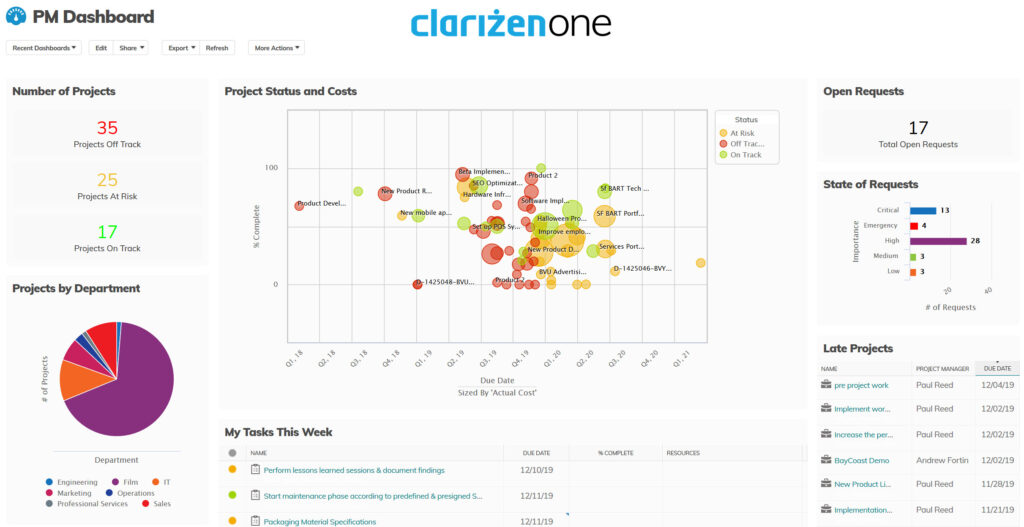
Planview Adaptive Work (formerly Clarizen) is an enterprise project and portfolio management software that helps you have real-time visibility into all workstreams. Planview enables PMO and EPMO leaders to optimize project portfolios, balance capacity, prioritize work and manage resources. Clarizen connects work across the enterprise by merging project management, collaboration, and workflow automation. Planview helps create an organization-wide view to drive accountability through workflows, measuring outcomes, and mitigating risk.
Top Features:
- Visualize the portfolio workload with waterfall, collaborative, or Lean-Agile views
- Real-time insights
- Empower every team to reach their goals through visibility
- Keep all stakeholders informed and teams aligned in one dashboard view
- Know the bottom line of every project decision with financial planning
Directly from the customer:
Rohan, Business Consultant said: “I have been dabbling with several Project Management Solutions in my current organization and earlier ones; Planview came across as a complete package. One of the most crucial factors I understand now is the consultant who works with you. Their expertise in project management and the in-depth knowledge of the solution are essential for the implementation and successful adoption of the solution in the organization. While the feature list of solutions available in the market is easier to compare, such expertise cannot be gauged earlier on.”
Pricing: Professional Edition: $30/user/month. Enterprise Edition: $45/user/month. Unlimited Edition: $60/user/month. There is no free plan option, but a 30-day free trial period is available upon request.
6. Zoho
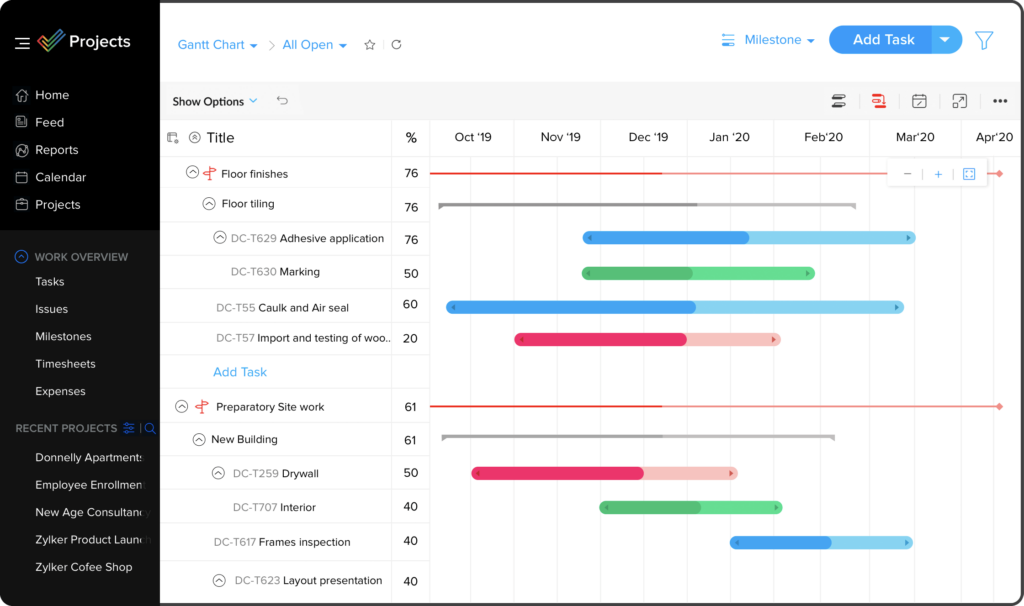
Zoho Projects is a cloud-based project management software that helps teams track tasks, plan work, and efficiently collaborate. Zoho’s interface makes it easy to manage projects with little to no learning curve. This solution is great for smaller teams with less complex projects who just need the basic traditional project management features. Their UI views have customizable color themes and dark and light modes to make them feel unique.
Top Features:
- Gantt charts to build your project plan
- Automate routine tasks
- Log billable and non-billable hours with timesheets
- Customize fields, layouts, and statuses
- Integrate with other Zoho apps and 3rd party apps
Directly from the customer:
Steven at TurningWest says: “Our presence is now completely virtual. We save a ton of money using Zoho Projects and appreciate that Zoho continues to evolve and improve.”
Pricing: Zoho offers three pricing options. Free | Premium $5/user/month | Enterprise $10/user/month
7. ClickUp
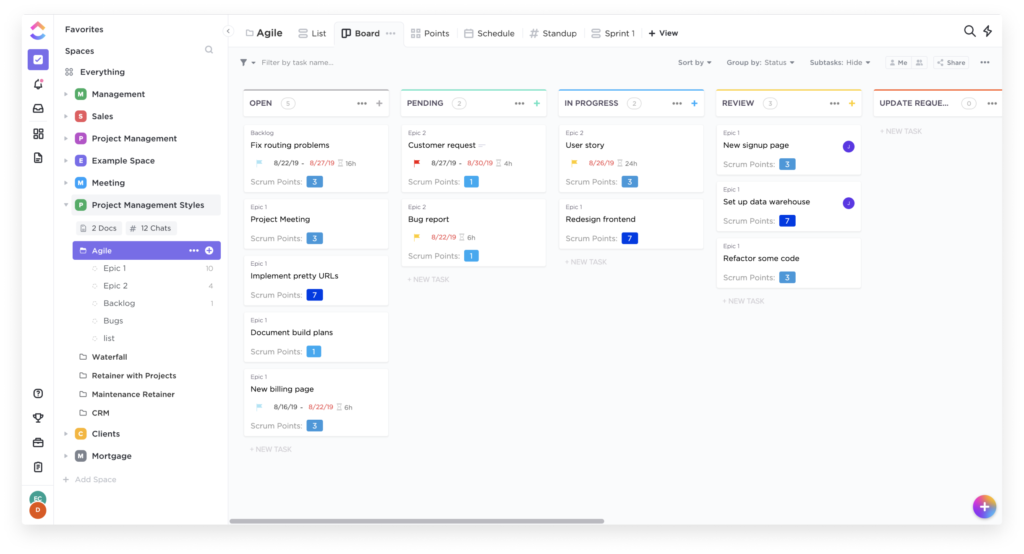
ClickUp is an integrated productivity platform designed to assist teams in planning, organizing, and collaborating on work. The application includes many integrations to customize projects and tasks with just a few clicks. ClickUp lets teams of all industries and sizes work more effectively in an all-in-one solution. ClickUp also has hundreds of automations to help teams assign tasks, comment on projects, update statuses, and connect with other tools easily.
Top Features:
- Various views including a whiteboard
- Customize tasks with 35+ ClickApps
- Import work from other tools
- Real-time chat in-app
- Project updates in real-time in Dashboards
Directly from the customer:
From Julia at a mid-market company: “ClickUp is easy to use and understand. I love that it can help me plan and prioritize my work and shared work with colleagues. I appreciate that there are multiple ways to view project spaces, and I love that I get a daily reminder of what’s on tap – this helps me to stay on top of things or reschedule as necessary when things get busy.”
Pricing: ClickUp has five different pricing options: Free | Unlimited $9/user/month | Business $19/user/month | Business Plus $29/user/month | Enterprise (contact sales for pricing).
8. Monday.com

Monday.com is a flexible platform to help teams have a birds-eye view of outstanding projects, available resources, and projected timelines. Monday.com’s visual design and straightforward interface help teams plan timelines, assign project tasks, communicate, and manage projects. The platform can be configured for all types of users, business sizes, and industries. Its features allow customers to centralize information, streamline projects, and improve collaboration across the organization.
Top Features:
- Simplify decision making with Dashboards
- Save time with automation and integrations
- Prioritize tasks using Kanban
- Visualize project timelines in Gantt charts
- Upload files and other documents
Directly from the customer:
Baptist, Director of Innovation says: “monday.com allows banks to be synchronized between the top-level management figures and local KPIs.”
Pricing: Monday.com offers 5 pricing tiers: Free | Basic $8/seat/month | Standard $10/seat/month | Pro $16/seat/month | Enterprise (call for pricing)
9. Microsoft PPM
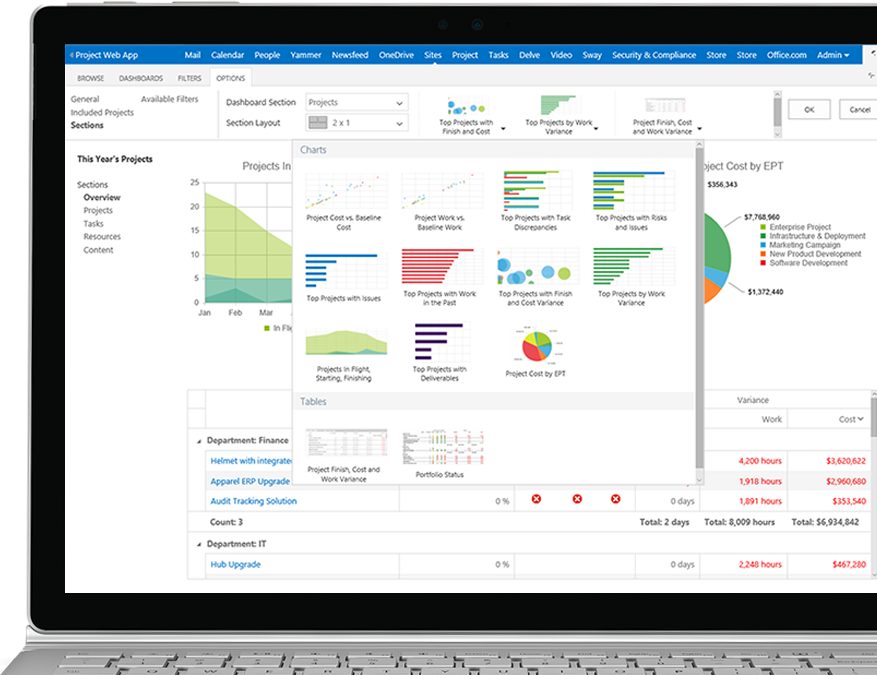
Microsoft Project offers customers ease and flexibility by providing customized work management solutions for individuals, teams, and enterprises. Microsoft Project effectively helps teams plan, prioritize, and manage project and portfolio investments. Teams use this software to weigh project proposals against strategic business drivers and consider the cost and resource constraints.
Top Features:
- Optimize portfolio by modeling scenarios
- Aggregate portfolios and projects in an interactive roadmap
- Share insights with built-in reports, such as burndown or Power BI dashboards
- Capture and evaluate project ideas
- Customized work views
Directly from the customer:
Mochammad, Technical Administrator says: “Microsoft Project allows me to organise projects and it also provides me with the tools I need. It’s pretty easy to use especially if you have experience in using other Microsoft products.”
Pricing: Microsoft PPM has 3 plan options: Project Plan 1: $10/user/month | Project Plan 3: $30/user/month | Project Plan 5: $55/user/month.
10. Smartsheet
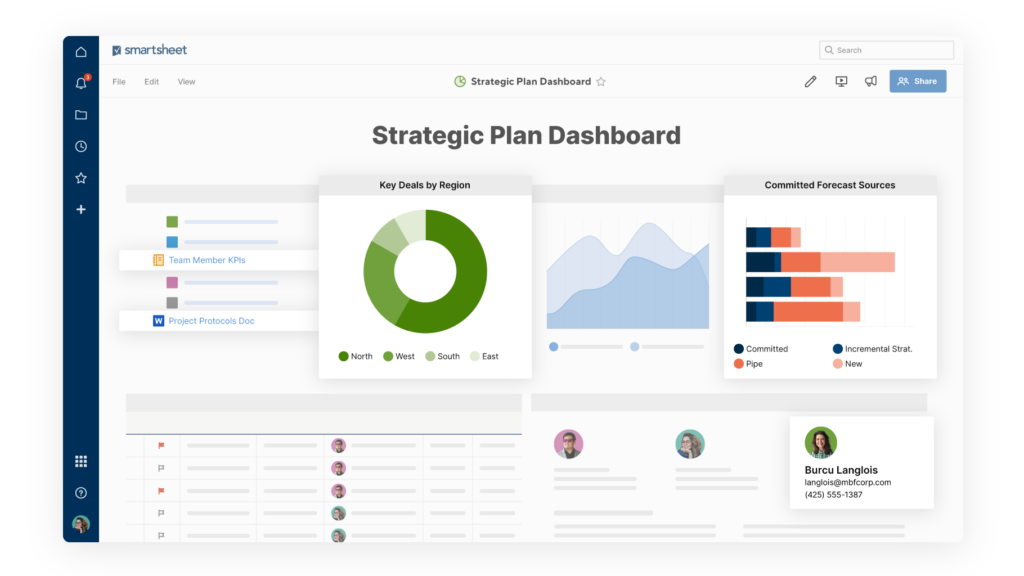
Smartsheet is an enterprise cloud-based platform for effective work management. Smartsheet empowers teams to plan, execute, and report on work. The software helps translate vision to real outcomes by aligning the organizational strategy with task execution. This PPM tool is a flexible platform to help connect strategy and execution. On-demand data analysis and automated reporting help teams prioritize and eliminate process inefficiencies. Checkout our Smartsheet comparison here.
Top Features:
- Integrate with many popular platforms
- Enable project consistency by standardizing processes
- Align vision with business reality with strategic planning
- Multi-tier intake feature to gather requests
Directly from the customer:
Frank, Program Manager, says: “Smartsheet has an excel-like interface that allows you to get started quickly, and then adds a ton of features around reporting, dashboarding and workflows that make tracking and managing projects and portfolios easy and effective.”
Pricing: Smartsheet offers three plan tiers with no free plan option. Pro from $7/user/month | Business $25/user/month | Enterprise – call for details.
Summary
Overall, many PPM tools are available with a wide range of product features. As you’re deciding which software to pick, make sure you understand what product features are necessary and which ones are ‘nice to have’. You’ll need to balance these product features with price constraints. While some tools are quite affordable, others are much more expensive. The more expensive the tool doesn’t necessarily mean it’s better suited for your organizational needs. If you’re searching for software for an enterprise organization, this is where you may be able to get the best deal in terms of price per seat in conjunction with product features and benefits. Sometimes detailed product training and other professional services may be included in the enterprise pricing or available for an ad hoc fee. It’s also important to note that certain software is better suited for certain niches and industries.
The best way to decide if it’s right for you is to use the tool for a while. Comparing tools and using them side-by-side is a quick and easy way to assess functionality. But it can be a daunting task to learn multiple new tools simultaneously. We recommend starting with a product demonstration to get you jump-started.
One thing to be aware of during this process is the customer experience. This article did not highlight customer satisfaction metrics, which can be even more important than product features. Do your due diligence, read customer reviews, and assess how helpful the sales team and product advisors are during your exploration process. LiquidPlanner has a very high customer satisfaction rating, with 96% saying it’s critical to their success and 100% saying they love using LiquidPlanner, according to SoftwareReviews. Give LiquidPlanner a try today by scheduling a quick demo and starting a free trial.








